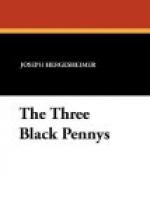XXXIII
The road to Myrtle Forge mounted between rolling cultivated fields, the scattered, stone ruins of walls erected in the earliest iron days; and, after a pastoral course, came to the Forge dwelling, its shuttered bulk set in a tangle of bushes and rank grass. An ancient beech tree swept the ground with smooth, grey limbs, surrounded by long-accumulated dead leaves. James Polder shut off the motor by the low, stone wall that supported the lawn from the roadway; he crossed to the farm, where the house keys were kept, and Howat and Mariana moved slowly forward. A porch, added, the former said, in Jasper Penny’s time, extended at the left; and they stood on the broken flooring and gazed down at a featureless tangle once a garden and the gnarled remainder of a small apple orchard beyond.
Polder soon returned, and they proceeded to a door on the further side, where the kitchen angle partly enclosed a flagging of broad stones. Inside, the house, empty of furnishing, was a place of echoes muffled in dust; the insidious, dank odours of corrupting wood and plaster; walls with melancholy, superimposed, stripping papers; older, sombrely blistered paint and panelled wainscoting varnished in an imitation, yellow graining. It was without a relic of past dignity. Mariana was unable to discover a souvenir of the generations of Pennys that had filled the rooms with the stir of their living. Once more outside they sat on the stone threshold of an office-like structure back of the main dwelling and indulged in cigarettes.
The disturbing tension of last night, Howat thought comfortably, had vanished. Mariana was flippant, James Polder enveloped in indolent ease. “The Forge,” Howat Penny told them, “was below.” A path descended across a steep face of sparse grass; and, at the bottom, Polder’s interest revived. “It stood there,” he indicated a fallen shed beyond a masoned channel, choked with the broken stones of its walls and tangled shrubbery. “You don’t suppose a joke that size was the great Gilbert’s plant. Here’s the drop for the water power; yes, and the iron pinions of the overshot wheel.” He climbed down a precarious wall, and stood perhaps twelve feet below them. Securing a rough bolt, he brought it up for their inspection. “Look at that forging,” he cried; “after it has lain around for a century and a half. Like silk. Charcoal iron, and it was hammered, too. Metal isn’t half worked any more. We could turn that into steel at almost nothing a ton.” He showed them in the mouldering shed the foundation of the anvil, traced the probable shafting of the trip hammer, marked the location of the hearths. “Three,” he decided; “and a cold trickle of air. A nigger pumping a bellows, probably. No, they could get that from the wheel,” he drew an explanatory diagram in the blackened dust.




